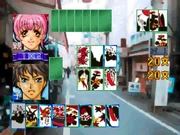|
- This article focuses exclusively on Nintendo Hanafuda cards. For the article that deals with all playing cards by Nintendo, see Nintendo playing cards.
Nintendo opened its doors in 1889, and the first product that they manufactured was Hanafuda cards. Hanafuda (花札 ?) are playing cards of Japanese origin that are used to play a number of games. The name also literally translates as "Flower cards." The name also refers to games played with those cards.
Nintendo's Hanafuda cards became so well known across Japan that Nintendo eventually started to develop other classic Japanese and Western card games. Their experience in creating card games led them to the toy business and ultimately the video game industry. Today they still produce a few Hanafuda card decks including the popular Daitouryou variant, which features the portrait of Napoleon.
History
Playing cards were banned throughout all of Japan when the government deemed multiple aspects of Western culture illegal due to the surge in Christian missionaries from Europe. In order to get around this, the Japanese developed an alternative to playing cards called Hanafuda, which replaced numbers with the twelve months of the year. Despite the government eventually banning these as well, the Japanese played the game in secret. In the late eighteen hundreds, Japan finally lifted the ban on playing cards. Fusajiro Yamauchi, an avid Hanafuda player, was thrilled to finally be able to play his game legally and opened up a company that would distribute high quality cards. The company's name was Nintendo.
Nintendo developed many different hanafuda decks with each one featuring different designs. The most famous one of all is the Daitouryou deck, also known as the Napoleon deck, which featured an image of Napoleon's face on the cover. To this day Nintendo sells this deck, and apparently it is the most successful one on the market. Today each deck is made out of card and paper and are placed in a nicely made plastic storage box.
Nintendo's other well known deck is the Miyako No Hana Hanafuda Deck. It doesn't sport an image of a political ruler, but is rather more traditional. Today the cards come in black or red depending on the person's preference. This deck is also much cheaper than the Napoleon deck at around $15. Despite this it also comes in a plastic box.

Various Mario characters.
In 2007 Nintendo released special Mario themed hanafuda cards through their Club Nintendo service. Once a person accumulated 400 points in Japan, then they could get the Mario cards for free. The deck featured is supposed to reflect the Daitouryou deck Nintendo published way back, with even the characters on the cards posing in the same way as the people in the other cards did (such as Mario posing in exactly the same way Napoleon stood).
The characters that were featured in the hanafuda set included (from clockwise top right in the image): Bowser, Mario, Yoshi, Lakitu, Luigi and Waluigi, Paragoomba, Toadies, Boo, Donkey Kong, Wario, Blooper, Koopa Troopa, Peach and Toad, and Piranha Plant.
In December of 2008, Nintendo opened up Club Nintendo in North America. The Mario Hanafuda cards were available among many other prizes. It, along with Game & Watch Collection, were the most expensive products available at 800 points each.
Trivia
- One of Nintendo's first video games "Super Mario Bros." pays tribute to Hanafuda with the Fire Flower & Piranha Plant .
- Nintendo has continued its historic tradition of Hanafuda in many card-based video games, like Arcana, Yu-gi-Oh! and Pokemon card games, and many more featured, some featured here .
- You can also find odes to it in non-card Action/Adventure titles like Super Mario Bros 3. Besides it's power-ups & iconic enemies, SMB 3 has a mini-game called Mario's Matching Game where you match up cards like coins, 1-up blocks, Starman, mushrooms, and yes, even flowers.
List of video games

Image from 64 Hanafuda.
The following are a list of video games with Hanafuda in them in one form or another.
- 1500DS Spirits Vol. 5: Hanafuda - Nintendo DS (Japan only)
- 64 Hanafuda: Tenshi no Yakusoku - Nintendo 64 (Japan only)
- Clubhouse Games - Nintendo DS
- Hanafuda - Super Famicom (Japan only)
- Hanfuda Ou - Super Famicom (Japan only)
- Hanafuda Trump Mahjong: Depachika Wayounaka - Game Boy Advance (Japan only)
- Honkaku Hanafuda GB - Game Boy Color (Japan only)
- Karan Koron Gakuen: Hanafuda - Mahjong - Game Boy Color (Japan only)
- Pocket Hanafuda - Game Boy Color (Japan only)
- Super Hanafuda - Super Famicom (Japan only)
- Super Hanafuda 2 - Super Famicom (Japan only)
Legacy
- In the Game Boy Camera accessory, one of pictures in the B-Album contains artwork from one of Nintendo's Hanafuda cards.
- The Japanese version of the Quite Puzzled microgame from WarioWare: Touched! features a Hanafuda card.
- In Pikmin 2, a treasure named the Talisman of Life is actually a case of Hanafuda playing cards.
